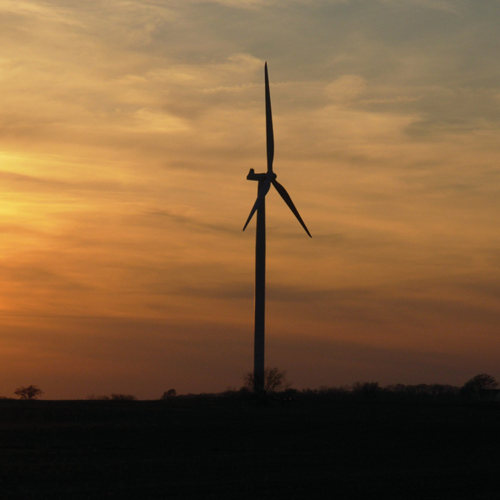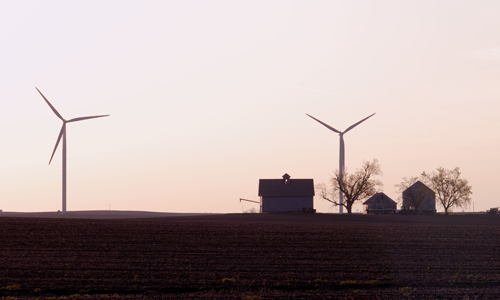Illinois is a national leader in the wind power industry.
Illinois built its first wind farm in 2003, and today, the Land of Lincoln is home to more than 3,800 megawatts of wind generation—enough to power more than one million homes. Existing wind development makes Illinois the nation’s fifth-highest state for installed wind generation, and more wind companies have U.S. or global headquarters in Illinois than any other state.
The costs for wind generation have fallen precipitously in the past decade—a decrease of more than 66 percent since 2009. This single factor has led more utilities and businesses to invest in wind energy nationwide, and wind is now the nation’s fastest-growing energy source.
Local Growth Drivers
Three key factors have contributed to Illinois’ leadership position: resources, infrastructure and policy. The state has moderate-to-strong wind resources. Though our winds may not be as strong as in Texas or the Dakotas, our wind resources can be harnessed effectively and profitably.

But a great resource is irrelevant if the power can’t reach users. Thankfully, Illinois has a robust electric transmission infrastructure, our second major growth driver. Many of the high-voltage transmission lines in central and northern Illinois are connected to the PJM electric grid—a vast, interconnected group of utilities supplying power to more than 50 million people in 13 Midwest and East Coast states. Illinois’ wind resources are stronger than those other states, meaning generators here can export power to buyers in the East.
The third driver is supportive government policy. Like most states, Illinois has a “Renewable Portfolio Standard” that requires utilities to purchase an increasing amount of wind and other clean energy sources. That 2007 law has helped put hundreds of megawatts of wind generation on the market since it was enacted, but technical flaws in the law have hindered growth. A bipartisan group of state legislators are now backing the Illinois Clean Jobs Bill to fix these technical problems, but the bill has been caught up in the larger battles in the Statehouse.
The Greater Peoria area is at the epicenter of wind development in Illinois. Hundreds of wind turbines tower over corn and soybean fields within an hour’s drive of Peoria, providing an export commodity to other parts of the nation. The closest wind farm is the 100-megawatt Rail Splitter project, located between Morton and Lincoln, which sells its power to a group of municipal utilities in Indiana.
Meanwhile, as the industry grows, area universities are preparing students for these new opportunities. In Bloomington-Normal, the Center for Renewable Energy at Illinois State University hosts the nation’s first bachelor’s degree program in renewable energy. In addition, researchers at Western Illinois University are studying wind energy technology and benefits for rural areas, while Richland, Sauk Valley and Highland community colleges have all instituted wind turbine technician programs.
Economic Benefits & Cost Savings
Illinois has already benefitted from this explosion in wind development, as wind farms bring millions of dollars into our communities. According to a July 2016 study by Dr. David Loomis at Illinois State University, the state’s existing wind farms will bring more than $6.4 billion in new economic benefits over the next 25 years. This includes $30.4 million in new property taxes and $13.86 million in income to landowners who lease land to wind farms, as well as the creation of over 20,000 construction jobs and nearly 900 operations and maintenance jobs.
Wind power enjoys bipartisan support in Illinois because it creates benefits across the state. Businesses from Chicago to Peoria are working in the wind supply chain, and rural areas like Livingston and Bureau counties are seeing massive investments in new wind farms. All this means jobs and economic growth for a state in which both are in short supply. Best of all, wind power saves businesses and individuals millions on their electric bills. A 2011 study by the Illinois Power Agency found that renewable energy generation has reduced wholesale electric prices by $177 million per year—and that was when Illinois had far less wind generation.
 Businesses Take Notice
Businesses Take Notice
The nation’s largest corporations are taking notice of wind’s benefits. Across the country, companies are making real investments in renewables because it makes business sense.
Electricity can be among the largest expenses for a large, industrial power user, and fluctuations in power prices can cause unexpected financial difficulty. But because wind has no fuel cost, a wind farm can sell power to users at a fixed rate for upwards of 20 years. No other generator can offer such price stability. For buyers, a long-term power-purchase agreement with a wind farm can mean a significant hedge against rising energy prices.
Illinois is at the forefront of this trend. In 2014, Microsoft inked a deal to buy wind power for its Chicago-area data center from the Pilot Hill wind project near Kankakee. In Vermillion County, a furniture retailer actually purchased a wind farm near Hoopeston, which it is now using to power its stores in the U.S. These projects are unique because they are long-term investments of hundreds of millions of dollars. It’s hard to discard these actions as “greenwashing” or PR… wind just makes business sense!
The Future is Bright
Of course, no industry is without its challenges. The energy sector is changing rapidly, and the wind industry must continue to innovate or risk losing to competition from cheap solar or natural gas. Siting is also an issue, and many communities in Illinois have seen brutal battles for local wind farm permits.
But despite the difficulties, the wind sector is strong and growing in Illinois. And while this renewable energy source is not the whole answer to our energy problems, wind power can be safely and reliably integrated into our existing energy mix. With smart planning and stable policy, we can ensure it is part of a robust economy and a smarter, cleaner energy future. iBi
Kevin Borgia is a Public Policy Manager for Wind on the Wires, a nonprofit dedicated to advancing renewable energy in the Midwest. Visit windonthewires.org for more information.


